The hard work, determination, and selflessness of these seven individuals ensured the "Return to the Hilltop" plan became reality.
Maura Marshall, A.P.R.N., M.S.N.

Director of Health Services
When you mention Maura Marshall’s name to anyone on campus, the immediate reaction is a smile. And rightly so. It is, in large part, due to the tireless work of this one superwoman that all of us on the Hilltop were able to return to campus, and resume a life as close to normal as possible during the roller-coaster year of the pandemic.
Marshall, who has worked for Saint Anselm since 2007, and as director of health services since 2009, oversees medical care, counseling, health education, and the college’s center for sexual violence on campus, The Harbor. She also is the chairperson of the college health committee and the alcohol and other drug committee. Her favorite role, she admits, is that of nurse practitioner, where she provides medical care for students in health services. In March of 2020, however, her responsibilities expanded exponentially as she began overseeing the Covid-19 lab, testing, isolation and quarantine for students—a role that quickly garnered her the nickname “Covid Queen.”
When she looks back over the past year and half, she remembers well what it felt like to be sending students home in the middle of the spring 2020 semester. “I was really sad,” she says. “A lot of people thought we were going to bring the students back to finish the semester and attend commencement, but I knew that was probably not going to happen. I was proud of our student affairs team and impressed at how the students rallied together, especially the [seniors], to make the best of their last days on campus and celebrate all of the senior traditions in such a short period of time.”
The feeling of sadness quickly transitioned to determination as Marshall, along with the senior leadership of the college, got to work creating the plan for what would become known as “Return to the Hilltop.” Marshall says, “The plans for the fall started almost immediately in April. I remember sitting down with Bill Furlong, vice president and CFO; Alicia Finn, vice president for student affairs and dean of students; and Dr. Favazza, and they looked at me and said, “We need to bring students back to campus in the fall—what do we need to do to make that happen?’”
"It was imperative we identify students who had Covid as soon as possible before it spread and caused outbreaks."
- Maura Marshall, A.P.R.N., M.S.N.
Marshall remembers those early days as a flurry of meetings, research, consulting, and community outreach. “We had about seven different working groups all strategizing how we could bring students back to campus safely,” she says. “I do think I may have been a member of every single group, and everyone was looking to me for guidance. We needed to evaluate every space on campus for distancing, we needed resources for disinfecting, PPE, options for remote learning, isolation and quarantine space, and Covid testing available on campus.”
It quickly became clear a return to the Hilltop would not be possible without the ability for rapid testing of students. “Due to the Covid virus being so contagious and presenting in people as asymptomatic carriers, it was imperative we identify students who had Covid as soon as possible before it spread and caused outbreaks,” she says. “When we decided to move all students back to campus in the fall, we knew we had to test everyone on move-in and attempt to create a ‘bubble,’ and we were extremely fortunate to acquire our Sofia 2 rapid antigen analyzer.”
Obtaining Sofia 2 was not without hiccups, and would not have been possible without Daron Montgomery, director of athletics. “We were promised two analyzers before the students moved in, but then they were taken by the government agencies to control the deaths in long-term care facilities,” she says. “Thankfully, Daron was able to utilize his professional contacts to obtain a Sofia 2 analyzer that became our lifeline to staying open.”
While there were a few more bumps in the road, Marshall is happy to look back at this past year now almost completely in the rearview mirror, and marvel at the teamwork of everyone on campus. “When I outlined everything that was needed to bring the students back, and keep them on campus, and having full support from administration, I knew, with hard work, we could make it happen,” she says.
Still, “making it happen” would not have been possible without the grit and determination of Marshall. “In October, while testing in Sullivan Arena, which was set up like a classroom, I asked why the ice wasn’t in yet, and I was told that they didn’t think we would make it this far,” she says. “That made me even more determined to make it happen—I’m not afraid of Covid, and I’m not afraid of hard work.”
Daron Montgomery

Director of Athletics
If you’ve ever walked anywhere on campus with Daron Montgomery, director of athletics, you know he moves at lightning speed. His quick reflexes and purposeful stride help him cover a lot of ground, fast, usually while juggling several other jobs along the way. It’s no wonder then, this same quick thinking and swift reaction time, combined with a natural ability for building relationships, helped the college obtain crucial rapid testing equipment, Sofia 2—without which the college would not have been able to bring students back to campus for the 2020-21 academic year.
Montgomery, who oversees the day-to-day operations of 17 varsity sports, 16 head coaches, and a program encompassing 480 student athletes, found himself in April 2020 leading the planning task force to review all scenarios for the fall of 2020. “We recommended to the Saint Anselm College Board of Trustees in June 2020 to bring students back to campus,” he says. “And a big piece of being able to do this was understanding testing protocols.”
As Marshall mentioned, the college found itself in a difficult situation upon learning the two analyzers expected from the government were redirected elsewhere, leaving a big question mark on how plans for bringing students back would proceed. Enter Montgomery, and his ability to establish and maintain relationships reaching beyond athletics.
"We recommended to the Saint Anselm College Board of Trustees in June 2020 to bring students back to campus. and a big piece of being able to do this was understanding testing protocols."
- Daron Montgomery
“The college being able to obtain Sofia 2 goes back to a longtime friendship I’ve had with Gene DeFilippo, the former athletic director for Boston College, who is now a consultant for Vivature, a practice management software company in Dallas, Texas,” Montgomery explains. “In 2016, DeFilippo introduced me to Muzzy Bass, CEO of Vivature, regarding exploring a partnership around a software program that tracks student-athlete visits to the sports medicine facility.”
Montgomery recounts a phone call he received in mid-July of 2020 from Bass and DeFilippo gauging his interest in this same testing equipment they had since pivoted to encompass rapid testing for Covid-19. “Vivature was partnered with Quidel, a manufacturer of diagnostic healthcare products in San Diego, California, who manufactures rapid testing machines for Covid—and pro sports teams were looking to resume at that time, but in order to do so needed rapid testing—Muzzy and Gene told me one of the machines slated to go to the New York Yankees was no longer needed, and asked if we were interested.”
After a long day filled with conference calls between Montgomery, Bass, DeFilippo, and Bill Furlong, vice president and CFO, an agreement was reached for the Sofia 2 to be redirected to Saint Anselm. “Needless to say, it was also satisfying, especially for Bill, who is a lifelong Red Sox fan, to know we were getting the machine originally slated for the New York Yankees.”
The equipment arrived in late July, and by August 8 the campus was ready to begin testing students. By January, the athletics department secured two additional testing machines from Quidel through an agreement they reached with the NCAA. These additional machines allowed athletics to ramp up NCAA/NE10 required testing cadence during the spring semester.
“We wouldn’t be here today, on campus, without Sofia 2,” says Montgomery. “The stars really aligned when I got that phone call back in July.”
Mike Sirois
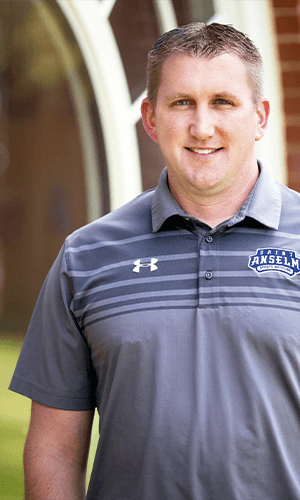
Head Athletic Trainer
Mike Sirois is one of those rare individuals who is not shy about offering to help. Entering his 17th year as head athletic trainer for the college, Sirois oversees the sports medicine department, with student athletes’ health always top of mind. So, when the college obtained the Sofia 2 machine for rapid testing of students last summer, it wasn’t a surprise when Sirois was one of the first to raise his hand to offer help in administering the tests.
“With my knowledge in medicine and sports medicine, it just made sense for me to jump in and learn how to use this equipment, along with the rest of my staff,” he says. Jump in, indeed. Within days of receiving Sofia 2, the college was preparing to welcome returning students—leaving little time to learn the equipment, administer the test, and manage the flow of students during testing and move-in.
We were all excited to be back and the energy was high, and we all trusted one another, and everyone came together to do their part.
- Mike Sirois
During those early days of moving students in, Sirois recounts overseeing the testing of approximately 200 students a day. “The sports medicine staff worked every day of check-in, running rapid antigen Covid tests,” he says. “In between all of this, we also were onboarding our student athletes with baseline concussion tests.”
The move-in process, while executed swiftly, was seamless. The college partnered with ClearChoiceMD for the 10-day move-in plan, where every student was screened, had a medical evaluation, and then moved on to Sirois and his team for a rapid and PCR test.
While the timeline was tight, Sirois trusted the process. He says, “Testing was crucial for bringing students back, and we were all a little nervous. What if results didn’t go well? But we were all excited to be back and the energy was high, and we all trusted one another, and everyone came together to do their part.”
Results did go well, with only two positive rapid tests and two confirmed PCR tests during that 10-day move-in. And by second semester, Sirois saw his time spent focused back on athletics, overseeing the testing of student athletes, who in the second semester were given permission to return to play. And while Sirois couldn’t have been happier to offer his help in seeing the college through such a challenging year, he’s also ready for a return to normalcy. “We’ve all learned so much this past year, but I have to admit I look forward to not being in a lab next year, but back on the field.”
Rosemary Stackpole
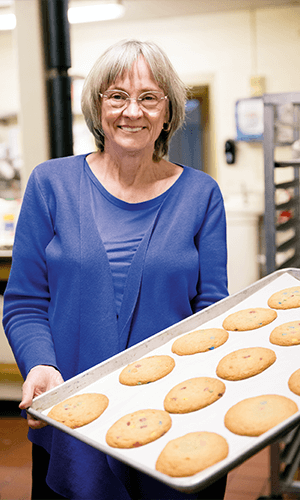
Director of Dining Services
During her 42 years on the Hilltop, Rosemary Stackpole, director of dining services, has never seen a year quite like this past one. But, even though she had never experienced anything like Covid-19, somehow she knew just what to do in order to keep dining services humming.
“As we moved into late spring and I learned more about our reopening plans for the fall, one of the first things I did was call our Pepsi Cola distributor and ask him to supply us with three open-air bottle beverage coolers for grab-and-go drinks,” she says. “This was before anyone really had an idea of how long this was going to be, or what it was going to entail, and he thought I was crazy, but I knew we needed to move away from self-service stations.”
This intuitive thinking helped Stackpole position all dining areas on campus for a safe dining experience for all students, staff, and faculty. “I worked with Don Moreau in facilities to install plexiglass shields to protect our servers, and I had to minimize lines, and rethink seating,” she says. This resulted in some unpopular decisions, such as needing to close down the grill area, which would see dozens of students, staff and faculty waiting in line for popular grill items. It also included reducing the seating in Davison from 750 seats to 150, and working with IT to implement a new dining card-swiping ability to limit contact between cash register and student. Thousands of dishes were moved into storage and replaced with grab-and-go containers, and self-service condiment dispensers were substituted for single packs.
Another change came with the implementation of the online ordering system for the Coffee Shop and Gallo Café, and Davison dining reservation system. “We knew we needed to manage the flow of students and keep crowds down, and while students miss eating in the Coffee Shop, and especially visiting the Pub, people like being able to order their food and have it waiting for them when they’re ready,” she says. The reservation system also allowed Stackpole and her team to usher 75 students through Davison every 15 minutes.
As seamlessly as she handled all of the campus dining options, she also made sure students in quarantine and isolation were well fed. “Maura and I set up a system where every day she would email me the names of students in isolation or quarantine, and I would then email that student with directions on how to order food, and then call to follow up to make sure they understood how it worked—I wanted to make sure they knew they could order anything they liked,” she says. “Our administrative assistant, Michele Lavoie, would write up the order, charge their meal plan, and take it to the kitchen where the food would be prepared, packaged and placed in brown shopping bags. Rob Browne, director of security and safety, and his officers would pick up and deliver.” Stackpole says this happened three times a day, at 8 a.m., noon, and
5 p.m. “When we were reaching those high numbers just before Easter break, we were packaging about 90 meals a day—it was getting rough,” she says.
But, at the end of the day, what matters most to Stackpole are happy customers. “A father of a student emailed Dr. Favazza and cc’d me on what a wonderful job the college did when his child was in quarantine, and how amazing the food was,” she says. “That, to me, is the best.”
Mike Murphy
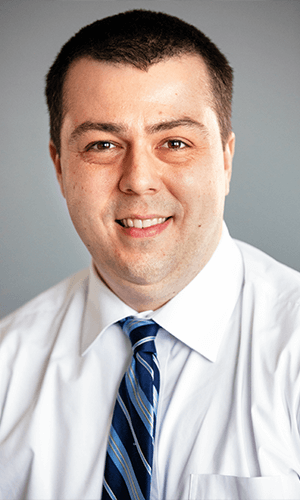
Assistant Director of Residential Operation
Planning for a student’s on-campus experience during a pandemic, when in-person activities and contact were limited, had its challenges to say the least. Just ask Mike Murphy, assistant director of residential operation. “Residence life is a big part of what a student being on campus looks like,” he says. “Our first priority was keeping students safe, but with that came so many questions.”
The first of which being, how to determine housing. “When students left in March 2020, they hadn’t picked their housing yet for the next year,” he says. “This was always held in person in Sullivan Arena.” Murphy and his team transitioned to a virtual system, which ended up being a huge success. “This was absolutely a silver lining to the past year, students loved it because it was a very transparent process, where they could see what rooms were available and what place they were in line,” he says.
The next hurdles involved how to train staff virtually for the upcoming year on how to interact safely, minimize clusters, and define what a family unit meant. “We came to the decision to define a student’s family unit as whoever you are sharing a bathroom with,” he says.
Our first priority was keeping students safe, but that came with so many questions.
- Mike Murphy
Planning for where to place students in isolation or quarantine also required a group effort among health services, physical plant, and residential life. “The reality is some students were going to contract Covid, and while the immediate thought might be to send that student home, that’s not always an option for everyone, depending on whether someone is immunocompromised at home, or if they live too far away,” he says. Murphy got to work coordinating the refitting of space for students in Collins House, as well as the fourth floor of Alumni Hall.
When numbers were spiking prior to Easter break, Murphy saw his available beds dwindling. “When the decision was made to send students home before Easter break, it was utter relief for me,” he says. “I was looking at spaces we had, and we didn’t have enough beds—in some instances when someone was released from isolation at midnight, someone else needed to be moved in by 8 a.m.”
For Murphy, the success in finishing out the year with students on campus was a team effort. “Everywhere you looked, staff and faculty were coming together for the students,” he says. “The good in this is seeing everyone come together.”
Rob Browne ’95
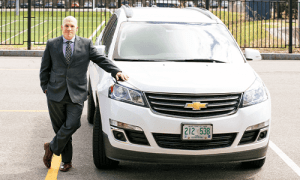
Director of Safety and Security
As the former chief of police for the Goffstown, N.H., police department, Rob Browne ’95, director of safety and security, is used to handling anything that comes his way—a skill that served him well this year as he and his team took on several new roles to keep students safe while on campus.
“Once we knew the plan for bringing students back, we set the wheels in motion, working closely with physical plant on pedestrian flow for each building and dorm, designating specific entry-only and exit-only doors, and up and down stairwells, as well as the residence life staff on how to limit crowds, and what student groups to bring back first,” he says.
Browne also oversaw the creation of a call center to answer the many questions from parents and students associated with the monumental move-in. “Heather Arsenault in our office was a thoroughbred here, we could not have done it without her—answering questions for hours, ranging anywhere from ‘Where can I park?’ to ‘How many family members can help move me in?’ and ‘What time is my move-in slot?’ to ‘Where do I go for my rapid test?’”
"If it fell to any one department, I don't think we would have made it. It truly takes a village."
- Rob Browne '95
Willing to do whatever needed doing, Browne and his team also helped move students into isolation, as well as deliver food to them three times a day. “If a student tested positive on campus, Maura [Marshall] and I would pick up the student in front of their residence hall and move them into one of the rooms designated for isolation,” he says. “We needed to do this in one trip, and we were carrying everything from clothes and televisions to computers, backpacks, medications and linens—all with N95 masks.”
When numbers were climbing before Easter break, Browne recalls many long days of picking up meals in Davison, moving students into isolation, and handling many unexpected situations. “When you have Covid, your sense of smell is gone,” he says. “Maura and I would walk into the room of a student whose isolation was ending at midnight but would need to be occupied by someone else by 8 a.m., and the trash would be overwhelming.” True to form, Browne and Marshall never skipped
a beat, and got to work cleaning.
“Maura and I would just look at each other and laugh before digging in to clean—what else can you do in that situation but laugh?”
While there were many hard days, Browne credits the campus-wide teamwork for getting through the past year. “If it fell to any one department, I don’t think we would have made it,” he says. “It truly takes a village.”
Brinna Martin ’24
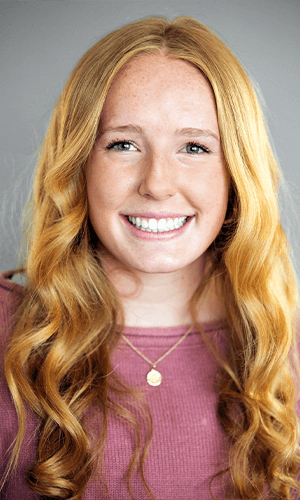
For an example of what strength, perseverance, and patience looks like— look no further than Brinna Martin ’24.
The freshman biology major from St. Michael, Minn., and member of the women’s hockey team, not only completed her first year of college during a pandemic, but also navigated a whopping 47 days in quarantine.
While Martin never contracted Covid-19, she was considered a close contact to students who did, and therefore found herself in quarantine on four different occasions throughout the year. “The hardest part was testing negative so many times but still having to quarantine,” she says. “It was just so frustrating.”
While Martin remembers many late-night phone calls home to her parents in Minnesota, she also credits the support of her friends, teammates, and coach for helping her through the isolation. “My coach and teammates have been wonderful—we did a lot of Zoom calls, played virtual trivia games, and I also had a lot of body workouts to do, which helped beat the isolation.”
Even with more than a month and a half of quarantine under her belt, Martin couldn’t imagine going to school anywhere else. “It may sound strange, but even though having to quarantine so many times was awful, I’ve had the best year,” she says. “All of my friends are great, and being able to just sit on the quad to study and listen to music, or watch a movie and hang out, it’s been such a great year.”
